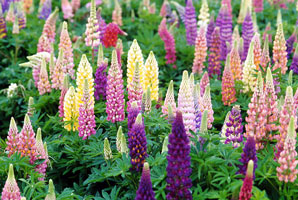5/24/2013
The Art of Growing Lupines
Jeremy Windemuller

Lupines are a must-have for retailers in spring. They offer incredible impulse appeal with their tall, stately spires of colorful blossoms and fly off the shelf when in bloom. Here are a few tips for getting your lupines to bloom when customer traffic is at its peak.
Potting and timing
Lupines are commonly sold in both 1-qt. and 1-gal. pots at retail. If growing in quarts, start with a 72-ct plug in spring and allow 6 to 8 weeks for plants to bulk up before sale. If growing in gallons, you have the option of starting with 72-ct plugs in early fall or 30-ct plugs in spring. Allow 10 weeks for 72-ct plugs to bulk up before overwintering or 8 weeks at 62F (16C) for 30-ct plugs to finish in spring.
Cultural recommendations
Moisture—Lupines prefer average soil moisture and require good drainage to thrive. Water them thoroughly and allow the soil to dry slightly between waterings. Plants that are held under wet conditions become prone to anthracnose. It’s best to water in the morning and allow the foliage to dry before evening.
Lighting—Lupines require long days to flower. To force them into bloom earlier in the year, day-extension or night-interruption lighting can be effective.
Temperature—If starting your lupines in the fall, grow them under natural temperatures, but maintain air temperatures above 50F (10C) until plants are rooted in. Once they’re well-rooted, they can be shut down for winter and vernalized for 6 to 8 weeks or longer under 40F (4C) in minimally heated greenhouses or unheated cold frames. If growing lupines in spring, grow them cool at 60 to 65F (15 to 18C) constant air
temperatures.
Growing Media and Fertility—Lupines prefer to be grown in a well-drained, bark-based growing mix, which allows for better drainage. They don’t like heavy soils. A slightly acidic pH of 5.8 to 6.2 is best in production. Lupines are light to moderate feeders. Fertilize with a constant liquid feed of 75 to 100 ppm nitrogen at every irrigation or 150 to 200 ppm nitrogen as needed. If using a controlled-release fertilizer mixed into the growing media, use at a medium rate of 1 lb./cubic yard. The recommended EC rate using the pour-through method is 2.0 to 2.5.
Pests and Diseases—Lupines can be affected by several insect and disease issues, so it would be wise to maintain a preventative spray rotation on a biweekly basis. Scout for aphids, whiteflies and thrips, treating as necessary. Also watch for downy mildew, powdery mildew, anthracnose and rust. Drenching plants with a broad-spectrum fungicide at transplant can help to prevent disease. Crown and root rots can be prevented by not growing plants wet, especially at night.
Finishing tips
Controlling Size—Though the Popsicle series of lupines is naturally more compact, PGRs can be used on lupines if necessary. Spray the foliage completely with PGRs once the leaves reach the outer edges of the pots. To control the height of the flower stems, apply a PGR when they just begin to elongate above the foliage.
Forcing—Lupines that were planted the previous fall and then vernalized can be forced into bloom ahead of their natural cycle. Bring them out of dormancy by placing them in a greenhouse with 60 to 65F (15 to 18C) constant temperatures and use day extension or night interruption lighting to provide long days. Your lupines should begin to flower in 10 to 12 weeks under these conditions.
GT
Jeremy Windemuller is a grower and trial manager for Walters Gardens, Inc. in Zeeland, Michigan.